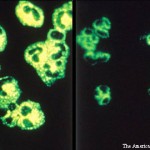In addition to the conventional end points, the researchers also used patient Visual Analog Scales (VAS) to assess patient-reported outcomes. At six months, they saw no difference in patient VAS scores for disease activity, but they did see a difference in treatment toxicity, with patients in the reduced-dose group reporting significantly less treatment toxicity than patients in the high-dose prednisolone group.
Decreased Side Effects
The reduced-dose prednisolone group had significantly fewer objective serious adverse events, including serious infections and predefined glucocorticoid-related adverse effects, such as diabetes, insomnia and all infections, than the high-dose prednisolone group.
The investigators documented two deaths in the reduced-dose group and three deaths in the high-dose group, a difference that was not statistically different. Two patients in the study developed cancer—one developed colon cancer in the reduced-dose group and one developed lung cancer in the high-dose group. The investigators documented 21 serious adverse events in 13 patients in the reduced-dose group and 41 serious adverse events in 24 patients in the high-dose group. Seven serious infections occurred in five patients in the reduced-dose group and 20 serious infections occurred in 13 patients in the high-dose group.
With regard to opportunistic infections, the investigators documented only two cases of Pneumocystis pneumonia in the lose-dose group. In contrast, the high-dose group had one case of varicella, one case of miliary tuberculosis and two cases of invasive aspergillosis.
“The results are mostly consistent with the results of the PEXIVAS trial,” says Dr. Hojjati, “except in this trial patients were not as sick as in the PEXIVAS trial, and patients with severe glomerulonephritis or alveolar hemorrhage were excluded from this trial.”
These most recent data, in combination with the previous research, collectively indicate that, for most patients with ANCA-associated vasculitis, the total dose of glucocorticoids during the remission-induction phase could be reduced when glucocorticoids are combined with appropriate, potent treatment, such as rituximab.
“Rheumatologists can achieve similar results using only half the standard dose of steroids currently being used for remission induction in patients with ANCA-associated vasculitis [without severe glomerulonephritis or alveolar hemorrhage] and experience lesser side effects in their patients,” says Dr. Hojjati.
Lara C. Pullen, PhD, is a medical writer based in the Chicago area.
References
- Furuta S, Nakagomi D, Kobayashi Y, et al. Effect of reduced-dose vs high-dose glucocorticoids added to rituximab on remission induction in ANCA-associated vasculitis: A randomized clinical trial. JAMA. 2021. 325(21):2178–2187.
- Jayne DRW, Merkel PA, Schall TJ, et al. Avacopan for the treatment of ANCA-associated vasculitis. N Engl JMed. 2021. 384(7):599–609.
- Smith RM, Jones RB, Specks U, et al. Rituximab as therapy to induce remission after relapse in ANCA-associated vasculitis. Ann Rheum Dis. 2020;79(9):1243–1249.
- Walsh M, Merkel PA, Peh CA, et al. Plasma exchange and glucocorticoids in severe ANCA-associated vasculitis. N Engl J Med. 2020;382(7):622–631.

